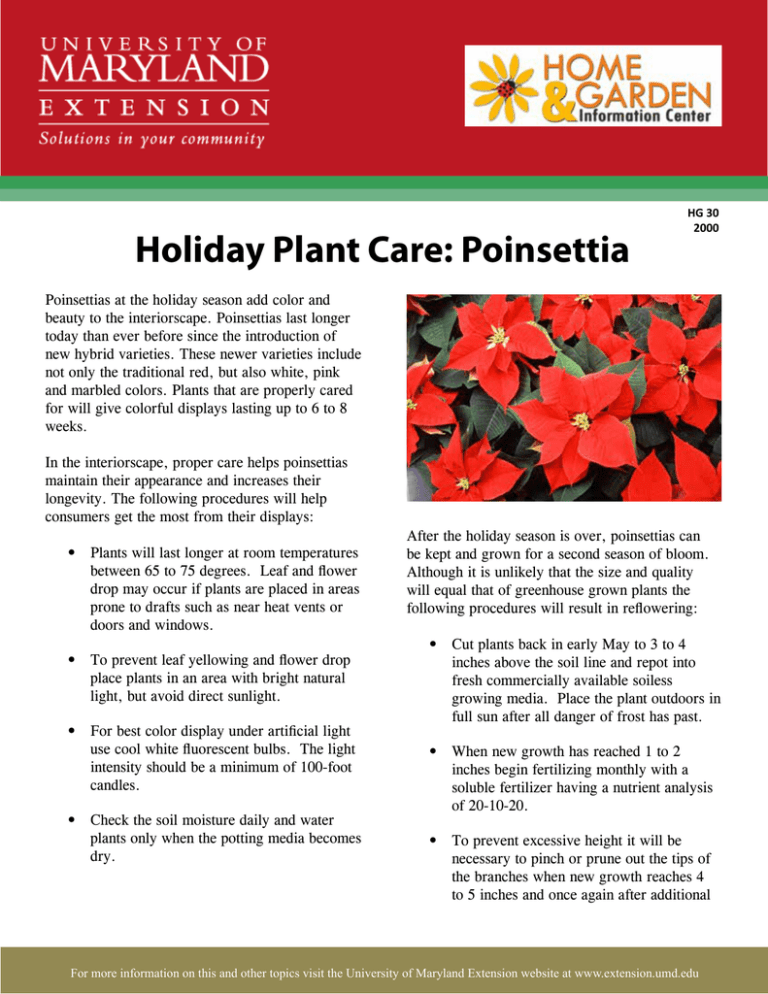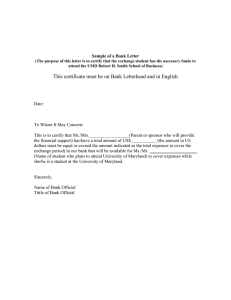Holiday Plant Care: Poinsettia
advertisement

Holiday Plant Care: Poinsettia HG 30 2000 Poinsettias at the holiday season add color and beauty to the interiorscape. Poinsettias last longer today than ever before since the introduction of new hybrid varieties. These newer varieties include not only the traditional red, but also white, pink and marbled colors. Plants that are properly cared for will give colorful displays lasting up to 6 to 8 weeks. In the interiorscape, proper care helps poinsettias maintain their appearance and increases their longevity. The following procedures will help consumers get the most from their displays: • Plants will last longer at room temperatures between 65 to 75 degrees. Leaf and flower drop may occur if plants are placed in areas prone to drafts such as near heat vents or doors and windows. • To prevent leaf yellowing and flower drop place plants in an area with bright natural light, but avoid direct sunlight. • For best color display under artificial light use cool white fluorescent bulbs. The light intensity should be a minimum of 100-foot candles. • Check the soil moisture daily and water plants only when the potting media becomes dry. After the holiday season is over, poinsettias can be kept and grown for a second season of bloom. Although it is unlikely that the size and quality will equal that of greenhouse grown plants the following procedures will result in reflowering: • Cut plants back in early May to 3 to 4 inches above the soil line and repot into fresh commercially available soiless growing media. Place the plant outdoors in full sun after all danger of frost has past. • When new growth has reached 1 to 2 inches begin fertilizing monthly with a soluble fertilizer having a nutrient analysis of 20-10-20. • To prevent excessive height it will be necessary to pinch or prune out the tips of the branches when new growth reaches 4 to 5 inches and once again after additional 1 For more information on this and other topics visit the University of Maryland Extension website at www.extension.umd.edu new growth reaches 2 to 3 inches. Avoid pinching after early September or flowers may not form in time for the holidays. • Bring plants inside by late September before night temperatures go below 60 degrees and reduce fertilizer applications. Place plants in areas that will receive as much natural light as possible. • Since poinsettias initiate flowers as the days get shorter any additional light from artificial sources will prevent flower development. To get bract color for the holidays it is necessary to give the plants no more than 10 hours of daylight and then place them in at least 14 hours of darkness each day. This can be done by placing plants under a box or in a closet each evening from 5:00 PM to 7:00 AM through Thanksgiving. Even a small light leak will prevent flowering. The plants are not as light sensitive once color has developed in the bracts. The most common problem of delayed flower development is caused by light pollution during the darkness period. Do you have a plant or insect pest question? Visit us at extension.umd.edu/hgic and click Ask Maryland’s Garden Experts Authors: David L. Clement and Thomas Blessington, University of Maryland Extension Specialists, Central Maryland Research and Education Center This publication is a series of publications of the University of Maryland Extension and The Home and Garden Information Center. For more information on related publications and programs, http://extension.umd.edu/hgic. Please visit http://extension.umd.edu/ to find out more about Extension programs in Maryland. The University of Maryland, College of Agriculture and Natural Resources programs are open to all and will not discriminate against anyone because of race, age, sex, color, sexual orientation, physical or mental disability, religion, ancestry, or national origin, marital status, genetic information, or political affiliation, or gender identity and expression. 2 For more information on this and other topics visit the University of Maryland Extension website at http://extension.umd.edu


